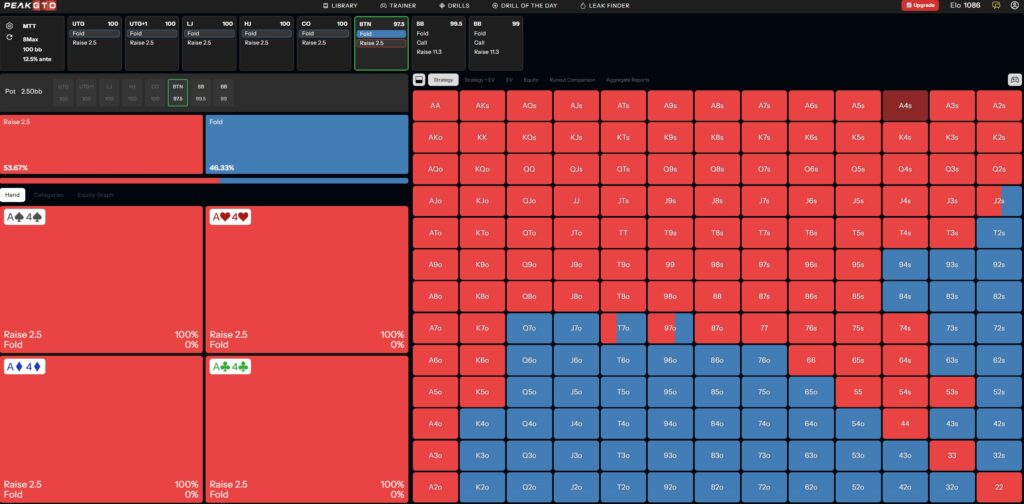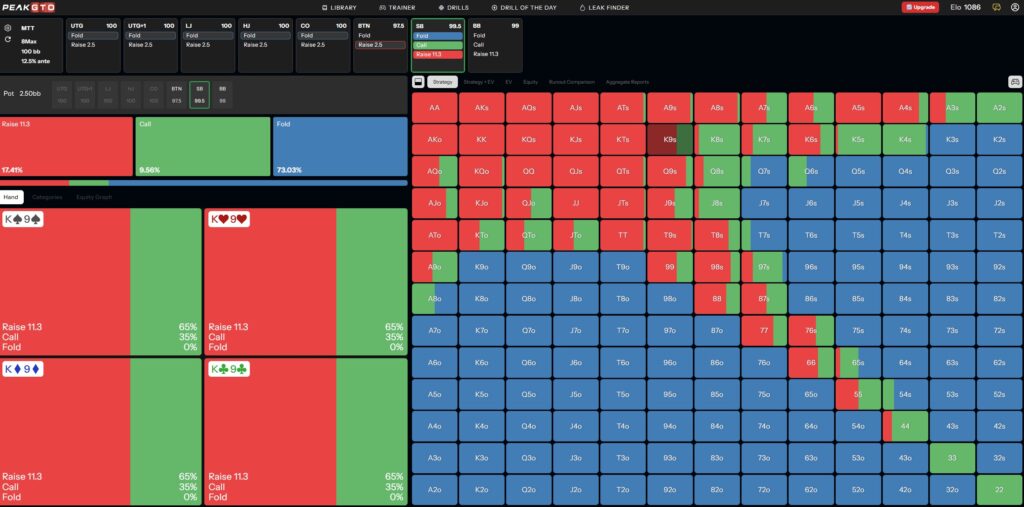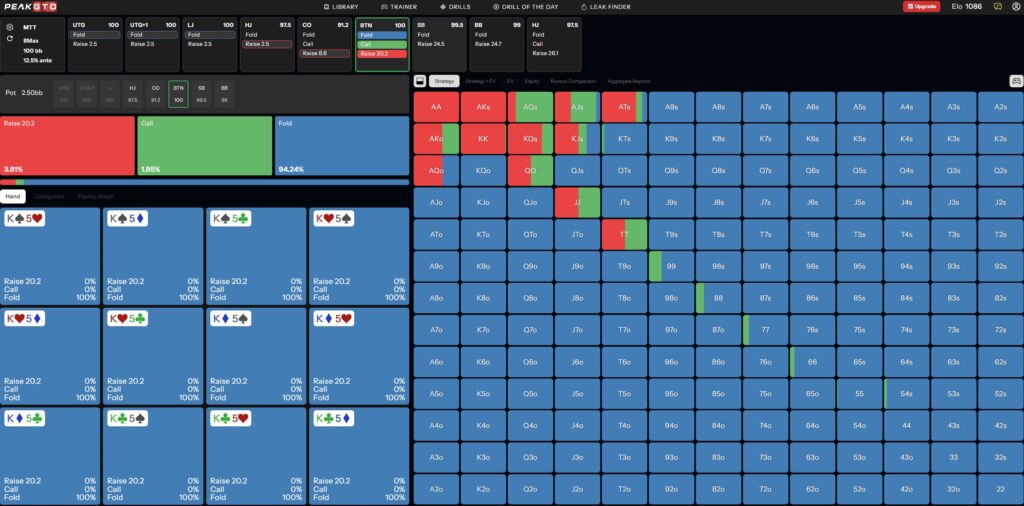Event poker rewards the gamers who assume deeper, actually. When stacks are 80, 100, and even 200 large blinds deep, the sides you possibly can carve out preflop are far bigger than while you’re quick. But many event gamers overlook these spots, defaulting to autopilot ranges constructed for mid-stacks.
That’s the place Jonathan Little’s Event Masterclass 2.0 steps in.

The revamped course builds on years of cutting-edge examine and stay expertise, educating gamers the best way to make higher choices at each stack depth. On this unique preview, Jonathan breaks down the core ideas behind deep-stacked preflop play, which is an space the place high execs persistently separate themselves from the sector.
These classes come straight from the Deep-Stacked Preflop part of Event Masterclass 2.0, and so they reveal how elite gamers take into consideration constructing ranges, responding to aggression, and creating postflop edges earlier than the primary neighborhood card even hits the desk.
Lesson 1: Constructing the Proper Deep-Stack Basis

Enjoying deep isn’t about memorizing charts. It’s about understanding how stack depth transforms the worth of your arms.
Jonathan begins by explaining that while you’re 100 large blinds deep, the potential reward of creating robust arms skyrockets, and the price of getting into pots grows with it. You may have extra implied odds, but in addition extra probabilities to get into hassle for those who misjudge your vary.
With this in thoughts, he recommends widening your playable arms in late place and including suited connectors, suited one-gappers, and suited aces whereas tightening up early. From beneath the gun at 100bb+, arms like KJo or ATo lose worth as a result of they’re simply dominated postflop. However on the button, those self same arms change into money-makers due to place and management.
The purpose, Jonathan explains, is to construct ranges that could make robust arms when deep, not simply arms that depend on top-pair worth. Suitedness and connectivity change into premium options, whereas weak offsuit broadways and small pairs lose their shine.
He additionally emphasizes the necessity to plan forward. Deep stacks imply excessive stack-to-pot ratios (SPRs) postflop, so your preflop selections should anticipate future streets. Keep away from arms that create reverse-implied-odds conditions and those that make “second-best” arms too usually.
“Whenever you’re deep, the arms that may make the nuts go approach up in worth. Place and hand potential are all the pieces.”
Lesson 2: Adjusting to Limpers, Raisers, and Callers at 100bb+

As stacks develop deeper, pots change into multiway extra usually, and that adjustments all the pieces. Within the subsequent collection of classes, Jonathan dives into the best way to deal with limpers, open raises, and calls when stacks are deep.
Towards limpers, the tenet is easy, and you must apply strain. Jonathan teaches a balanced however assertive response by elevating to a pot-sized quantity, which is roughly 3x the limp plus one large blind per limper. This isolates the weakest ranges whereas leveraging place to construct worthwhile heads-up pots.
For instance, if two gamers limp at 1,000/2,000 blinds, your elevate measurement must be about 6.5bb. This forces arms to fold or name at an obstacle, which is precisely what you need.
When dealing with a typical open, deep stacks reward artistic 3-betting.
- Jonathan encourages a polarized 3-bet technique versus broad opens from the cutoff or button, mixing robust worth arms with bluffs which have good blockers, akin to A5s, K9S, or QTs.
- Towards tighter opens, shift to a linear vary by 3-betting arms like AQ, JJ, and KQs that carry out properly when known as.
The identical logic applies when somebody opens and will get a name, the place you must establish who’s capped. If the flat caller can’t have AA or KK, you achieve leverage by 3-betting aggressively behind them. However be cautious at deep stacks, bloating the pot with speculative arms out of place can flip small errors into large losses.
“Your purpose isn’t simply to play extra arms — it’s to play them smarter. Each preflop choice ought to arrange a better postflop plan.”
Lesson 3: Superior 3-Betting, Squeezing & Chilly 4-Betting Technique

At 100bb+, preflop re-raising isn’t nearly power but in addition about leverage and composition, so we dissect how high gamers construct 3-bet and 4-bet ranges to maximise fold fairness whereas protecting their vary balanced.
The primary key idea is knowing who’s capped and who isn’t.
Whenever you 3-bet an early-position raiser, your vary is uncapped since it may well embody AA and KK, whereas theirs is normally robust however capped in the event that they name. That dynamic permits you to management the pot and strain them postflop, even when your precise hand is a bluff.
Jonathan emphasizes tailoring your 3-bet sizings by place:
- In place: 3.5x the open measurement is right.
- Out of place: 4–4.5x to disclaim fairness and make continuation bets simpler.
When somebody squeezes behind you, deep stacks make calling extra viable, particularly with suited connectors or pocket pairs. You may have sufficient behind to appreciate fairness
Then comes probably the most misunderstood weapons in event poker: the chilly 4-bet. Jonathan breaks down that you must primarily use it while you establish a polarized 3-bet vary and adequate fold fairness.
At 100bb+, he suggests chilly 4-betting polarized ranges of your personal, akin to premiums like QQ+ and AK for worth, and bluffs like A5s or KTs that block the strongest holdings.
“Chilly 4-betting deep is about steadiness. You’re not simply re-raising for worth however you’re additionally attacking opponents who 3-bet too liberally and might’t defend correctly.”
Bringing It All Collectively
Deep-stacked preflop play is the place ability really shines. It’s the place event professionals outmaneuver the sector, construct large stacks early, and set themselves up for final-table runs.
In Event Masterclass 2.0, Jonathan Little reveals not solely what to do in these conditions, however why constructing a structured system that turns complexity into readability.
By the tip of the deep-stack module, you’ll perceive the best way to:
- Assemble balanced and worthwhile opening ranges at 80–150bb
- Apply strain with well-timed 3-bets and chilly 4-bets
- Modify to limpers, multiway pots, and squeezes successfully
- Keep away from expensive errors that bleed chips early in tournaments
That is the place nice event runs start. After mastering preflop technique, you possibly can dive into postflop conditions the place Pokercoaching’s Event Masterclass 2.0 will provide help to grasp completely different areas of your play.

The publish Deepstack Technique Secrets and techniques of Profitable Gamers: 3 Classes for Preflop Mastery appeared first on My Poker Teaching.

